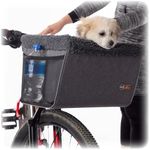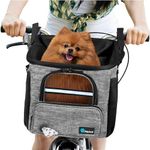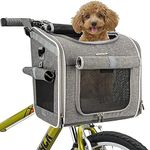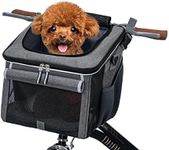Buying Guide for the Best Dog Bike Carriers
Choosing a dog bike carrier is all about ensuring your pet’s safety, comfort, and your own convenience while riding. The right carrier will depend on your dog’s size, temperament, and how you plan to use it—whether for short city rides or longer adventures. It’s important to consider how easy the carrier is to attach and remove, how secure your dog will be, and how comfortable both you and your pet will feel during the ride. Always prioritize safety and make sure the carrier is suitable for your bike type and your dog’s needs.Weight CapacityWeight capacity refers to the maximum weight the carrier can safely hold. This is crucial because using a carrier that isn’t strong enough for your dog can be dangerous. Carriers are usually divided into small (up to 15 lbs), medium (15-30 lbs), and large (over 30 lbs) categories. To pick the right one, always check your dog’s weight and choose a carrier that can handle a bit more than that, just to be safe. Never try to squeeze a larger dog into a smaller carrier, as this can be uncomfortable and unsafe.
Mounting StyleMounting style describes how the carrier attaches to your bike. The main types are front-mounted (on the handlebars), rear-mounted (on a rack or seat post), and trailer-style (pulled behind the bike). Front-mounted carriers are best for small dogs and let you keep an eye on your pet, but they can affect steering. Rear-mounted carriers are more stable and can handle heavier dogs, but your pet will be behind you. Trailers are great for larger dogs or longer rides, offering lots of space and comfort. Choose the style that matches your dog’s size and your riding habits.
Safety FeaturesSafety features include things like harness attachments, secure closures, reflective strips, and sturdy construction. These are important to keep your dog secure and visible, especially in traffic or low light. Some carriers have built-in leashes or harness clips to prevent your dog from jumping out. When choosing, look for carriers with multiple safety features, especially if your dog is active or nervous. Think about where and when you’ll be riding—more safety features are better for busy streets or night rides.
Ventilation and ComfortVentilation and comfort refer to how well the carrier keeps your dog cool and cozy. Good carriers have mesh panels or windows for airflow, and padded interiors for comfort. This is important because dogs can overheat quickly, especially on warm days or longer rides. If your dog has a thick coat or you plan to ride in hot weather, prioritize carriers with lots of ventilation. For comfort, look for soft padding and enough space for your dog to sit or lie down comfortably.
Ease of Use and InstallationEase of use and installation means how simple it is to attach, remove, and use the carrier. Some carriers have quick-release systems or fold for storage, while others require tools and more effort to install. If you plan to use the carrier often or switch it between bikes, look for one that’s easy to handle. Consider your own comfort with assembling things—if you prefer simple solutions, choose a carrier that’s straightforward to set up and take down.
Size and DimensionsSize and dimensions refer to the physical space inside the carrier. It’s important that your dog can sit, turn around, and lie down comfortably. Carriers come in different shapes and sizes, so measure your dog’s length and height before choosing. If your dog is still growing, consider a slightly larger carrier. A cramped carrier can make your dog anxious or uncomfortable, so always prioritize enough space for your pet’s comfort.













